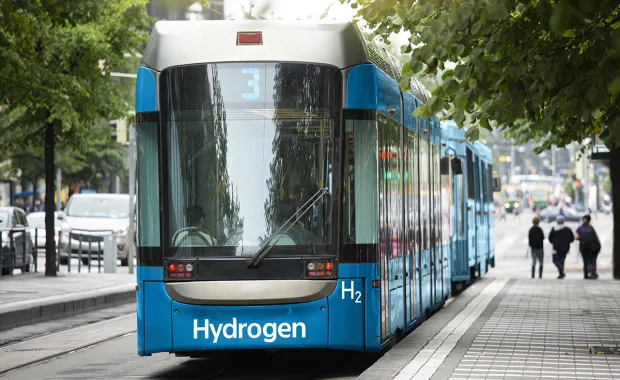As societies around the world work to achieve climate goals and reduce greenhouse gas (GHG) emissions, clean hydrogen – especially green, blue and pink hydrogen – is becoming a critical part of the solution.
When approaching this new opportunity, most organizations are focused on gaining experience around safety, energy efficiency, economic scaling and cost reduction in hydrogen production. Operators, meanwhile, focus predominantly on the asset and operational implications of hydrogen. However, there is a growing impetus for organizations to prioritize the technological considerations of dealing with hydrogen and GHG.
Based on European research and with input from our North American experts, this article explores key drivers of the hydrogen economy, and the importance of using data to coordinate across all areas of the hydrogen value chain, from production to end use.
Hydrogen’s role in improving energy security
In addition to its devastating human and economic toll, Russia’s invasion of Ukraine caused major disruptions of energy supplies. Radically increasing gas prices and the consequences for people’s daily lives sparked discussions on the need to scale-up alternate energy production in various European regions. The impetus for more local energy production stems from the need to move faster and to create energy independence from Russia.
Within this context, the European Union sees an opportunity to accelerate the global energy transition with the REPowerEU plan. This plan also strengthens and accelerates the development of hydrogen by:
- Committing to 10 million tons of European production of renewable hydrogen
- Introducing 10 million tons of hydrogen to replace fossil fuels and make the industrial and transport sectors more sustainable by 2030
- An additional €200 million funding for research to accelerate hydrogen projects
In North America, the U.S. and Canadian governments similarly announced legislation to support the development of hydrogen and clean energy economies:
- The U.S. Inflation Reduction Act, America’s most significant climate legislation to date, invests US$369 billion over ten years to build a clean energy economy
- The U.S. Department of Energy provides US$750 million in funding for clean hydrogen technologies
- The Government of Canada is investing CA$300 million, alongside CA$161.5 million from the province of Alberta, to support a project to advance clean fuels and clean energy in Canada
- The Ontario Government is establishing a Hydrogen Innovation Fund that will invest CA$15 million over the next three years to drive and develop opportunities for hydrogen to be integrated into Ontario’s clean electricity system
Researching ideas, gaining experience
For hydrogen economies to work well, several criteria are important. This includes the ability to certify the source of hydrogen supply as it enters the supply chain and track the additional carbon impacts of its delivery. Many industries and sectors are demanding clean hydrogen as energy quality and carbon content affects their ability to produce sustainable and lower carbon products.
Success criteria also includes the ability for network operators to determine strategic placement of electrolysis and storage to optimize supply. As well, success requires a joint plan of action for a hydrogen network at all levels of government, including the regulatory ability to proceed at pace and scale.
As these criteria present additional complexities and challenges, operators are conducting pilots to gather data to gain knowledge and experience around conversion. For example, European and North American industry associations are researching the suitability of injecting hydrogen (mixes and pure) using current assets, and the economic deployment of future pipelines.
In coordination with gas network operators, this research is investigating ideas at the local level to determine whether existing residential neighborhoods can convert to hydrogen-powered housing; and, at the regional level, developing industrial hydrogen hubs and how to connect them:
- Europe: aiming to connect Northern and Southern Europe through a Pan-European hydrogen backbone
- North America: aiming to scale supply chain and distribution in balance with increasing demand
Beginning your hydrogen journey
From a commercial standpoint, some companies have been producing hydrogen for industrial uses for close to a century, building extensive knowledge in the production of mostly grey hydrogen, which releases CO2. Economics play a large role in investment decisions, as businesses become more strategic about where to place their bets.
As a starting point, organizations can consider focusing on hydrogen use cases that have a clear line of site for success, such as:
- Fertilizers: hydrogen as feedstock to produce ammonia, which in turn used to produce fertilizer
- Chemicals: hydrogen as a feedstock to allow certain reactions to take place before the final product (for example, as a reactant to remove impurities)
- High-temperature processes: hydrogen as a feedstock for processes requiring high (>250°C) to very high temperatures (>400°C), in the production of green steel, for example.
- Maritime: hydrogen as a powerful energy source to propel large ships
- Transport and trucking: emerging hydrogen injection to offset CO2 and reduce diesel fuel consumption
- Fleet vehicles: large fleets of delivery, service, buses, etc., where there is a common and often central place that all vehicles connect to each day, where hydrogen fueling can be located
The importance of data and digitization
The value of data and technology will continue to increase in the hydrogen economy.
Businesses need to be strategic about using data to accelerate both decarbonization and the growth of a sustainable hydrogen market model.
As we’re seeing in Europe, and increasingly in North America, data allows organizations to better monitor and collaborate across projects, as well as track their large hydrogen investments.
For producers, this requires digitizing the functions needed in the system for flexible services, transport and storage of large quantities of hydrogen, as well as certifying its quality and source. For grid operators, it involves managing and controlling new hydrogen grids and existing infrastructure for potential (re)use for hydrogen. Real-time performance and optimization data enable decision-making that drives agility, cost diversification and higher efficiency.
For consumers, it means having access to a stable energy supply that can track and report on the carbon quality and delivery carbon impacts. This enables them to consume cleaner or greener products and meet their own quality and sustainability requirements.
The business value of data-driven decisions also gives rise to new projects that use machine learning (ML) and artificial intelligence (AI) as predictive tools. Such tools combine real-time data to address the impact of fluctuations in weather, market, supply and demand on hydrogen and renewables. This increases reliability and lowers operational costs. (Read how using AI helps predict failures in wind turbines)
The challenge facing many organizations is their legacy IT, which is designed for traditional energy sources and difficult to update for new energy products such as hydrogen and even renewable electricity. Are those environments flexible enough, both for immediate needs and future developments? Should we not look to other large volume industries like banking and learn from how they track and measure connections, data and contracts?
Many experts agree that the best solution is an integrated approach to data and technology and adopting smart, efficient work processes fueled by high-quality data. Such an approach opens the door to new opportunities for innovative green hydrogen solutions and business outcomes.
Learn more about building an integrated, green hydrogen ecosystem.



